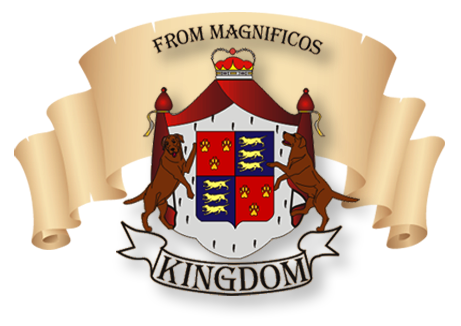Norfolk Terrier breed Standard
16.02.2011/EN
FCI-Standard N° 272
NORFOLK TERRIER
©J.Campin, illustr. KC Picture Library
This illustration does not necessarily show the ideal example of the
breed. St-FCI n°272/16.02.2011
2
ORIGIN: Great Britain.
DATE OF PUBLICATION OF THE OFFICIAL VALID
STANDARD: 13.10.2010.
UTILIZATION: Terrier.
FCI-CLASSIFICATION: Group 3 Terriers.
Section 2 Small-sized Terriers.
Without working trial.
BRIEF HISTORICAL SUMMARY: The Norfolk and Norwich
Terrier take their names, obviously, from the county and the city,
though turning the clock back to the early and mid-1800s there
was no such distinction, this being just a general farm dog. Glen
of Imaals, red Cairn Terriers and Dandie Dinmonts are among the
breeds behind these East Anglian terriers and from the resultant
red progeny emerged the present Norwich and Norfolk Terrier.
A typical short-legged terrier with a sound, compact body which
has been used not only on fox and badger, but on rats as well. He
has a delightful disposition, is totally fearless but is not one to
start a fight. As a worker he does not give up in the face of a
fierce adversary underground, and his standard’s reference to the
acceptability of ‘honourable scars from fair wear and tear’ is a
good indication of the type of. The Norwich Terrier was accepted
on the Kennel Club Breed Register in 1932, and were known as the
drop-eared Norwich Terrier (now known as the Norfolk Terrier) and
prick-eared Norwich Terrier. The breeds were separated in 1964 and
the drop-eared variety gained the name Norfolk Terrier.
GENERAL APPEARANCE: One of the smallest of terriers. Low,
keen dog, compact and strong, short back, good substance and bone.
Honourable scars from fair wear and tear permissible. St-FCI n°272/16.02.2011
3
BEHAVIOUR AND TEMPERAMENT: A “demon” for its size.
Lovable disposition, not quarrelsome, hardy constitution; alert and
fearless.
HEAD
CRANIAL REGION:
Skull: Broad, only slightly rounded, with good width between ears.
Stop: Well defined.
FACIAL REGION:
Muzzle: Wedge-shaped and strong; length of muzzle about one-third
less than measurement from occiput to bottom of stop.
Lips: Tight lipped.
Jaws / Teeth: Strong jaw, teeth strong and rather large; perfect,
scissor bite, i. e. upper teeth closely overlapping the lower teeth and
set square to the jaws.
Eyes: Oval-shaped, dark brown or black. Expression alert, keen and
intelligent.
Ears: Medium size, V-shaped, slightly rounded at tip, dropping
forward close to cheek.
NECK: Strong and of medium length.
BODY: Compact.
Topline: Level.
Back: Short.
Chest: Well sprung ribs.
TAIL: Docking of tail previously optional.
Docked: Medium docked, set level with topline and carried erect.
Undocked: Tail of moderate length to give a general balance to dog,
thick at root and tapering towards the tip, as straight as possible,
carried jauntily, not excessively gay. St-FCI n°272/16.02.2011
4
LIMBS
FOREQUARTERS:
General appearance: Clean.
Shoulder: Well laid back, approximately in length to upper arm.
Forearm: Front legs short, powerful and straight.
Forefeet: Round with thick pads.
HINDQUARTERS:
General appearance: Well muscled.
Stifle (Knee): Well turned.
Metatarsus (Rear pastern): Hocks well let down and straight when
viewed from rear; great propulsion.
Hind feet: Round with thick pads.
GAIT / MOVEMENT: True, low and driving. Moving straight
forward from shoulder. Good rear angulation showing great powers
of propulsion. Hindlegs follow track of forelegs, moving smoothly
from hips. Flexing well at stifle and hock. Topline remaining level.
COAT:
Hair: Hard, wiry, straight, lying close to body. Longer and rougher
on neck and shoulders. Hair on head and ears short and smooth,
except for slight whiskers and eyebrows. Excessive trimming
undesirable.
Colour: All shades of red, wheaten, black and tan or grizzle. White marks
or patches undesirable but permissible.
SIZE:
Ideal height at the withers: 25 cms. St-FCI n°272/16.02.2011
5
FAULTS:
Any departure from the foregoing points should be considered a fault and
the seriousness with which the fault should be regarded should be in exact
proportion to its degree and its effect upon the health and welfare of the
dog.
DISQUALIFYING FAULTS
• Aggressive or overly shy dogs.
• Any dog clearly showing physical or behavioural abnormalities shall
be disqualified.
N.B:
• Male animals should have two apparently normal testicles fully
descended into the scrotum.
• Only functionally and clinically healthy dogs, with breed typical
conformation, should be used for breeding.
The latest amendments are in bold character
